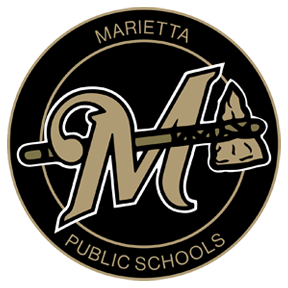Students were back to in-person learning after a shutdown resulted from several teachers being quarantined due to COVID-19. But instead of a two-week vacation, it was business as usual for most of that time as the district’s virtual plan kicked in immediately.
“I was actually impressed by how much teaching was going on, our staff’s concern for their students, and the students who took their education seriously by checking in with their teachers and completing their work,” said High School Principal Adam Sherfield. “It was a great team effort!”
According to teachers and administrators, the transition from in-person to virtual education was a smooth one, and it went well because of one thing: practice.
“I actually set my classroom up from day one like it was virtual,” said high school science teacher Charles Brown. “When my kids are meeting in-person, we do a mixture of lecture, labs and online learning.”
For Brown’s students and plenty of others, including Sara Gore’s in the middle school, the transition wasn’t such a big change.
“I’ve had several virtual days with my students since the beginning of the year,” said Gore, “so they were comfortable receiving their lessons and meeting virtually.”
Courtney Jackson, fourth grade teacher, has also practiced virtual learning with her kids.
“Knowing that distance learning could become a reality at some point during the school year, we started using Google Classroom right off the bat in August,” Jackson explained. “It’s been a part of our daily routine, so all of my students knew how to use their resources and complete their work.”
Another factor to success during the shutdown: routine.
Both Middle School Principal Carrie Tucker and Primary Principal Ann Rutledge spoke of the importance of routine for students, and of maintaining as much of a regular schedule as they could.
“As much as possible, we kept it just like being in school,” said Tucker. “Students were required to check in Goodle Meets at designated times, and teachers delivered content, just like normal.”
Middle school teachers also called on the parents of any students who weren’t checking in during those class times, making sure that parents were aware.
And Rutledge posted a “Morning Announcement Video” to keep the routine normal for younger students.
It seems that most students took their distance learning seriously and took care of business in the process.
“I met with my classes daily on Google Meet,” said elementary veteran Shari Hallum. “They could see me and I could see them, and the majority of my students were present everyday for online classes and completed the work I had assigned to them.”
Hallum voiced her gratitude to parents who encouraged their children to take distance learning seriously, making the best out of a tough situation.
Although some students did experience issues with devices and connectivity, those were quickly worked out.
“A high percentage of our students had their devices with them and were proactive in trying to find assignments and maintain their normal school day pace,” said high school English teacher Pam Higle. “And for our students who needed help, our principals Mr. Sherfield and Mr. Oakley helped ensure that the students had hotspots, Chromebooks, and the materials they needed. They helped us to problem solve and communicate with students and parents.”
As for the results of distance learning, the news is good.
“I’d say I got 80 to 90 percent return on the day I assigned things and another five percent the next day,” said Brown, “so all in all, not bad.”
Gore also reported that most of her students completed the assignments she made.
“I was very proud of the majority of my students who were responsible and didn’t let distance stop them from getting things done,” Jackson stated.
And although most of these educators would agree that in-person is better for kids, they know that the distance education they’re providing is making the most of the situation and that the quicker they can transition between the two, the better off their students will be.
“If we have to move to distance learning again,” stated Higle, “the transition should be even smoother with little disruption to the curriculum or academic pacing.”
Something that really helps encourage these educators is the large amount of positive parental feedback they’ve received.
“Transition has become a norm for us, and grace is offered by most,” said elementary teacher Bre Daniel. “The students and parents did a fantastic job trying to keep things as normal as possible and keep the education of students a priority.”
Many teachers mentioned the support of parents, and the willingness of kids to be flexible and adaptable, saying that distance learning doesn’t work without that. Maybe the key to making virtual education work is remembering that students, parents, teachers, and administrators are all on the same team.
“Our teachers were warriors, putting in long hours during the teaching day and then spending their evening hours answering calls, texts, and emails from parents,” said Elementary Principal Dana McMIllin, “and our students definitely were taught new concepts and skills, just like they were at school.”
Just the way it’s supposed to be.
